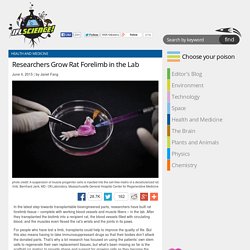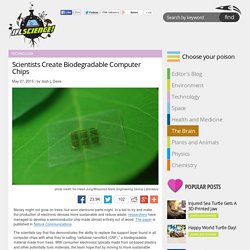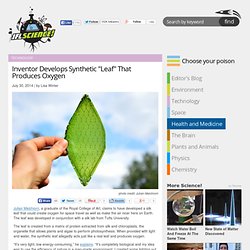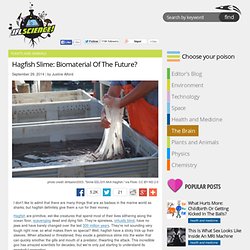

Vocativ. Micro Algae to Power Home – Fubiz Media. The Fungus That Could Replace Plastic. Our dependence on plastics is a major environmental issue.

Plastic barely degrades, and it’s filling our landfills and oceans faster than we can get rid of it. But scientists and designers have come up with a viable replacement for plastic in many of its applications: fungus. Motherboard correspondent Alejandro Tauber traveled to Utrecht University in the Netherlands to meet some of these scientists and designers. Professor and microbiologist Han Wösten explains that due to fungi’s filament-style growth, it can grow within different waste materials, simultaneously decomposing and fortifying them. For example, grown within wood pulp, the result is something like cork. In Zaandam, only a short drive away from Utrecht University, designer Eric Klarenbeek has already built sturdy furniture using this method. But as designer Maurizio Montalti shows Tauber, the fungus can be grown to emulate different types of plastic.
Researchers Grow Rat Forelimb in the Lab. In the latest step towards transplantable bioengineered parts, researchers have built rat forelimb tissue – complete with working blood vessels and muscle fibers – in the lab.

After they transplanted the biolimb into a recipient rat, the blood vessels filled with circulating blood, and the muscles even flexed the rat’s wrists and the joints in its paws. For people who have lost a limb, transplants could help to improve the quality of life. But this also means having to take immunosuppressant drugs so that their bodies don’t attack the donated parts.
That’s why a lot research has focused on using the patients’ own stem cells to regenerate their own replacement tissues, but what’s been missing so far is the scaffold (or matrix) to provide shape and support for growing cells as they become the complex tissues that make up a limb. “The composite nature of our limbs makes building a functional biological replacement particularly challenging,” Ott explains in a news release. Photo Gallery. Scientists Create Biodegradable Computer Chips. Money might not grow on trees, but soon electronic parts might.

In a bid to try and make the production of electronic devices more sustainable and reduce waste, researchers have managed to develop a semiconductor chip made almost entirely out of wood. The paper is published in Nature Communications. The scientists say that this demonstrates the ability to replace the support layer found in all computer chips with what they’re calling “cellulose nanofibril (CNF),” a biodegradable material made from trees. With consumer electronics typically made from oil-based plastics and other potentially toxic materials, the team hope that by moving to more sustainable materials that some of the problems of non-biodegradable waste might be alleviated. “The majority of material in a chip is support,” says Zhenqiang Ma, one of the authors of the paper. According to the researchers, over 426,000 cellphones were thrown in the trash every day in 2007 in the United States alone. Inventor Develops Synthetic "Leaf" That Produces Oxygen.
Julian Melchiorri, a graduate of the Royal College of Art, claims to have developed a silk leaf that could create oxygen for space travel as well as make the air nicer here on Earth.

The leaf was developed in conjunction with a silk lab from Tufts University The leaf is created from a matrix of protein extracted from silk and chloroplasts, the organelle that allows plants and algae to perform photosynthesis. When provided with light and water, the synthetic leaf allegedly acts just like a real leaf and produces oxygen. “It’s very light, low energy-consuming,” he explains. “It’s completely biological and my idea was to use the efficiency of nature in a man-made environment. Malchiorri isn’t content to just think of a few small fixtures within the house as the only use for this product.
"NASA is researching different ways to produce oxygen for long-distance space journeys to let us live in space,” he continued. Check out this video: 6CO2 + 6H2O + --(Sunlight Energy)--> C6H12O6 + 6O2. Hagfish Slime: Biomaterial Of The Future? I don’t like to admit that there are many things that are as badass in the marine world as sharks, but hagfish definitely give them a run for their money.

Hagfish are primitive, eel-like creatures that spend most of their lives slithering along the ocean floor, scavenging dead and dying fish. They’re spineless, virtually blind, have no jaws and have barely changed over the last 300 million years. They’re not sounding very tough right now, so what makes them so special?
Well, hagfish have a sticky trick up their sleeves. When attacked or threatened, they exude a gelatinous slime into the water that can quickly smother the gills and mouth of a predator, thwarting the attack. Hagfish slime is formed when seawater interacts with two different ingredients secreted by slime glands: mucin vesicles, which rapidly swell and burst in seawater, forming a gloopy net of mucus strands, and threads that are rich in a type of fiber called an intermediate filament (IF).